POST - 1881 LAND LINE TELEGRAPH EQUIPMENT (PART I)
W1TP TELEGRAPH AND SCIENTIFIC INSTRUMENT MUSEUMS: http://w1tp.com
PLEASE **WAIT** FOR ALL PICTURES TO LOAD !
(If some do not load, click "Reload Page".)
- Click BACK to Return to the Pevious Page.
EARLY LAND-LINE TELEGRAPH EQUIPMENT (1): (Approximately 1881 - 1890s)
(1001-1500)
EARLY STEEL LEVER KEYS (1): (Approximately 1881 - 1890s) (1001-1500)
After the Civil War, Railroads, Telegraph Companies, and Businesses
provided a growing market for the many types of apparatus being produced.
Attempts to avoid patent infringement led to new and interesting designs.
KEYS (1001-1500), KEYS & SOUNDERS (1501-2000), SOUNDERS (2001-2500),
REGISTERS, RELAYS, & OTHER (2501-3000)
(The instruments are in approximate chronological order: Oldest first.)
* = (Items no longer owned.) ** = (Items in other collections.)
PART I:
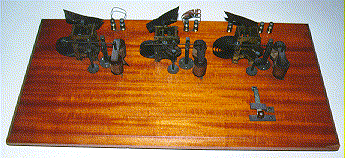
1005 THOMAS A. EDISON DUPLEX TELEGRAPH
MODEL:(30KB) This model, manufactured in Edison's laboratory consists of
a
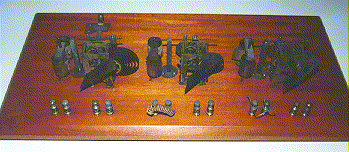
1 X 2 Ft. board (28KB) with
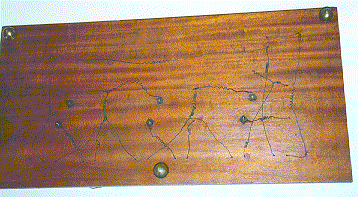
a set of wires on the bottom
(34KB). On this board, 3 wind-up clockwork mechanisms labeled "Terry
Clock Co. Waterbury, CT, Pat'd Dec 1, 1868 are mounted.
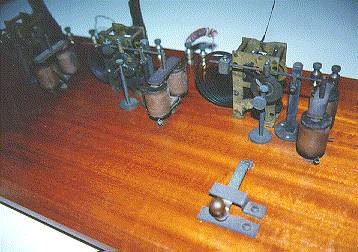
Each clockwork mechanism has had its
escapement removed and replaced with an air-propellor to govern its speed
(47KB). Each clockwork mechanism turns a
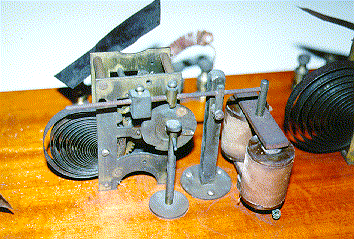
rotating disk that
makes contact with an adjustable wiper contact (46KB).
The disk has an

insulated spot that breaks
the contact at an adjustable point in its rotation (54KB).
The device was an early experimental model of a form of mechanical
time-division multiplex designed to allow 3 telegraph messages to be
sent on the same line.

1010 * K1BH's TRANSATLANTIC CABLE KEY:(32KB)
Small double (plated) lever key with ivory knobs on Gutta-Perchia
base stamped: Edouard BOUTY. Constructeur. Traded to K1BH, 1995.
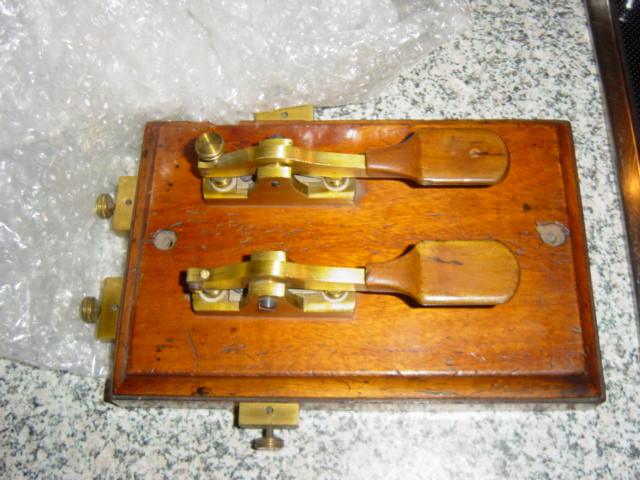
1011 * VERY EARLY EUROPEAN SUBMARINE TELEGRAPH CABLE KEY:
(61KB) This is an unusual and very early cable key. Some of the
insulators are ivory. The maker is not known.

1011a * Another view of the cable key:(60KB)
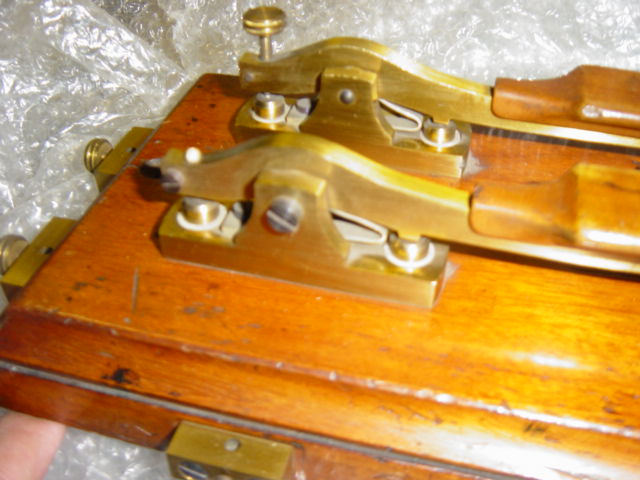
1011b * Another view of the cable key:(60KB)
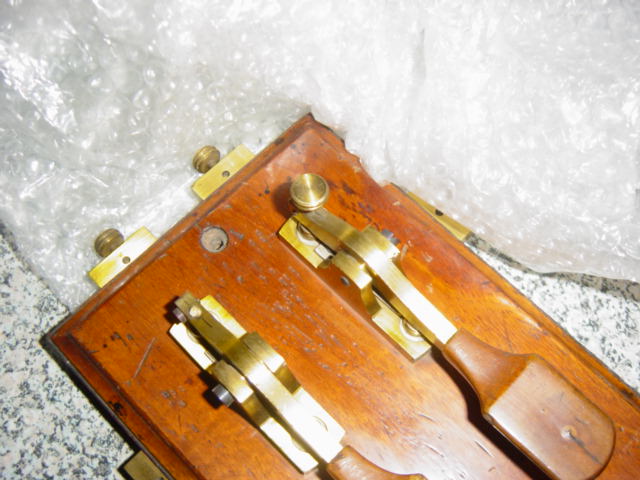
1011c * Another view of the cable key:(60KB)
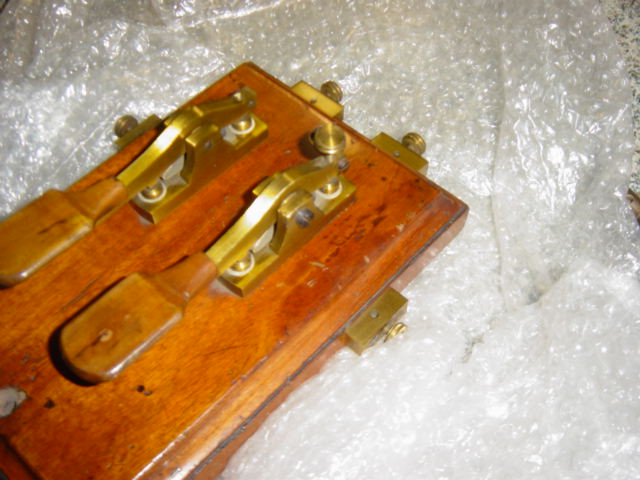
1011d * Another view of the cable key:(60KB)

1011e * A view of the wiring under the base of the
cable key:(60KB)
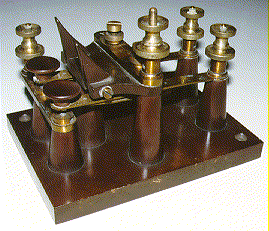
1012 SIEMENS BROTHERS CABLE KEY:(29KB)
This massive cable key has its entire mechanism mounted on high
columns above the base because of the high voltages which
were often necessary in order to transmit messages through
the very long cables. It measures 6-1/4"long by 4-1/2"wide
by 5" high. The base is stamped Siemens Brothers & Co. The
unusual triangular levers are used to hold the contacts in
the closed position.
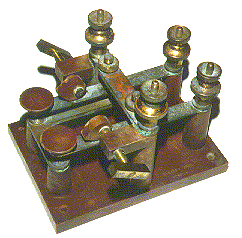
1014 * ELLIOTT BROTHERS CABLE KEY:(20KB)
Large and massive cable key similar to 1012 with the high
voltage columns but labelled Elliott
Brothers and with brass handled shorting cams.>K5VT
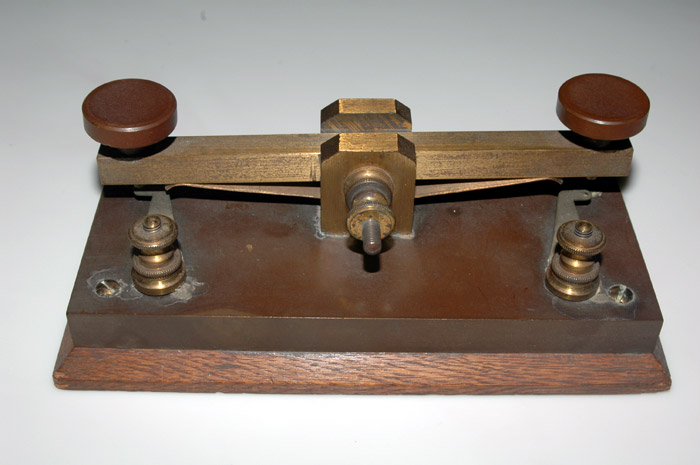
1015 UNUSUAL ROCKER-TYPE BRITISH CABLE KEY:
This is a very unusual cable key that uses a rocker-type mechanism.
Pressing the left knob puts a positive voltage on the cable and pushing the
right knob puts a negative voltage on the cable. There is no maker's name on
the key but the hardware strongly suggests that it is British.
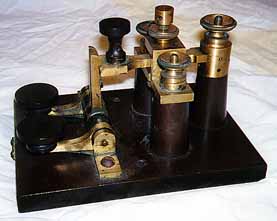
1016 * Ted Huston's CABLE DISCHARGE KEY:(14KB)
This large key was used to discharge the capacitances on
the long submarine cables in order to permit measurements.
The high columns isolate the high voltages on the mechanism from
the base. It is in the Ted Huston collection.
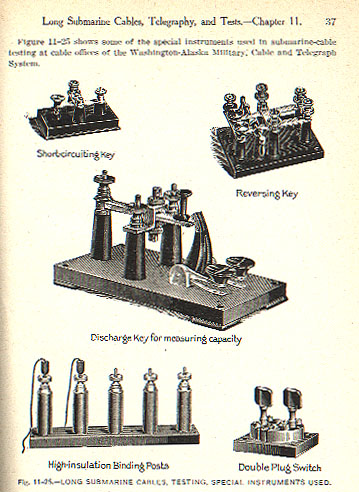
1019 * CABLE KEY LITERATURE SHOWING/DESCRIBING
ABOVE KEYS:(80KB)
This page shows some of the keys (shown above) which were used for
submarine telegraph signalling and testing on the Washington
to Alaska Military Cable and Telegraph System.
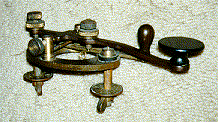
1020 * VERY EARLY AND UNUSUAL STRAIGHT KEY:(15KB)
Heavy long oval brass base with round hole in the middle. steel lever.
Extremely unusual round brass bar under steel lever runs between left
and right upright pivot posts. Shorting lever under this bar is
stamped WESTERN ELECTRIC CO.
1025 * VERY EARLY STRAIGHT KEY: Old all-brass key has a straight 1/4X1/4
inch brass lever bent down for an early-style knob. Wooden base with
cotton-covered wires embedded in channels on the underside. The spring
has a long gentle taper like Clapp-Eastham "Boston" key which it slightly
resembles.
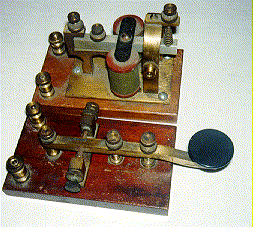
1026 * VERY EARLY STRAIGHT KEY & SOUNDER:(32KB)
Key like #1025 with matching sounder.
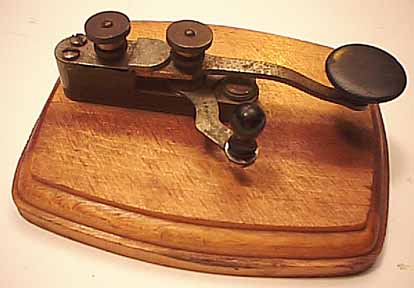
1050 BEARINGLESS ''STEINER'' KEY: (20KB)
The Steiner key is a very small key which is characterized by
having no trunnion or bearings. The lever is supported only by a spring
and knife edge. This one has a brass base which is stamped
W.E.Co. New York. Pat'd Dec.21,1880. Mounted on newer wooden base.
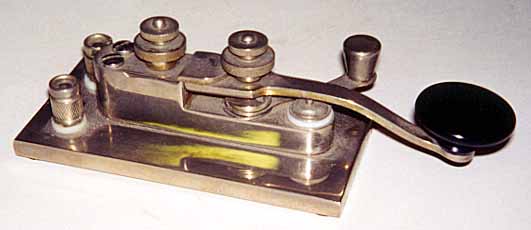
1054 ''RESTORED'' STEINER KEY: (17KB)
This is a small Steiner Key which has had its long legs cut off
so it could be mounted on a metal base. The key has been
chrome plated and the insulators have been replaced with white
plastic material. The shorting lever knob has been replaced with
a machined knob. I personally prefer to leave these keys in the
as-found condition with perhaps a light cleaning to remove dirt.
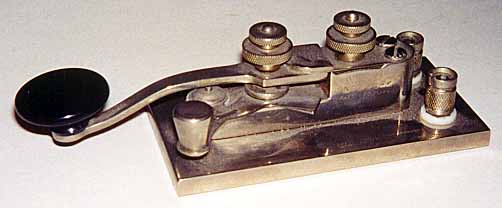
1054a Another
view of the ''RESTORED'' Steiner Key: (17KB)
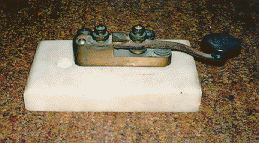
1055 STEINER KEY: (28KB)
This is a small Steiner Key whose design is characterized
by having no trunnion and the lever supported only by a spring
and knife edge. Brass base stamped W.E.Co. New York.
Pat'd Dec.21,1880. This one has been mounted on a newer marble base.
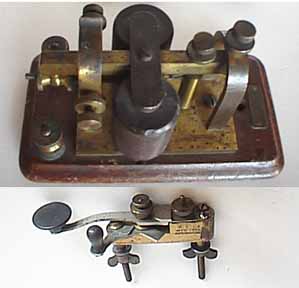
1057 * STEINER KEY WITH UNUSUAL WESTERN ELECTRIC
SOUNDER:(15KB)
This Steiner Key was used with this very unusual Western Electric
Sounder. The key has a brass base stamped W.E.Co. New York.
Pat'd Dec.21,1880. The sounder has an unusual round anvil. I believe that
this is a transitional design between the Western Electric
rectangular frame sounders and the Western Electric all round
frame sounders.
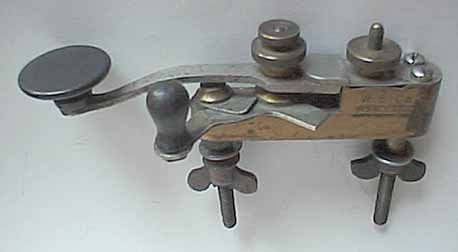
1057a * Closer view of the Steiner Key:(11KB)

1057b * Closer view of the Round-Anvil Western Electric
Sounder:(12KB)

1062 * PRIVATE-LINE CAST-BASE KOB WITH STEINER
KEY:(35KB) This KOB has a Steiner Key and sounder cast into
it's base. Private-Line KOB's were designed to be used on
''private telegraph lines'' in homes and businesses. They were
made on cast iron bases which were often decorated with flowers
and designs to better integrate into a home or business environment.
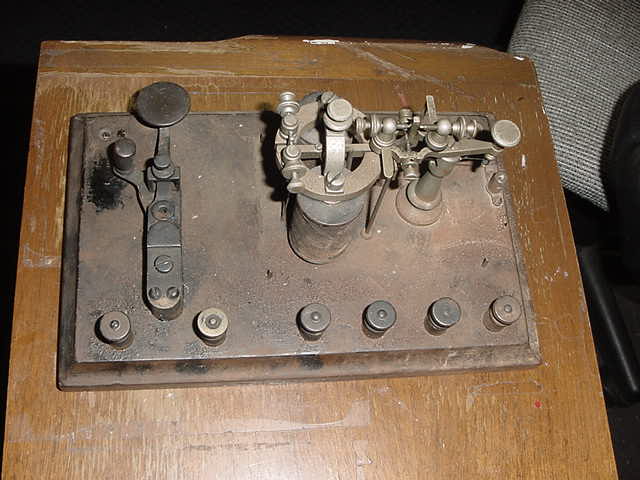
1067 EXCEPTIONALLY UNUSUAL STEINER KEY AND STRANGE AND
COMPLEX RELAY ON WOODEN BASE, KOB:(40KB)
This instrument was probably made and used by Western Electric since they
were the most frequent users of Steiner keys. Its base was covered with mud
indicating that it was immersed in a flood at some time. Removal of some mud
revealed that the base and key were painted black while the relay was nickel
plated brass.
The Steiner key is the only one if its kind that I have ever seen. It has a
rectangular frame over the lever. This rectangular frame converts the
normally-open contacts of the Steiner key into normally-closed contacts. All
of the Steiner keys that I have seen are configured like the one on the
Private-Line KOB and other Steiner keys shown above and have normally open
contacts and no rectangular frame. I believe that the closed-circuit feature
of this Steiner key was probably found to be necessary to work with the
complex relay system to produce some sort of duplex operation.
The most unusual feature of this instrument is the extremely complex relay
mounted on its wooden base. It was probably used in some kind of duplex
circuit. Duplex circuits often employed complex relays in an attempt to send
two signals on the same line and this is certainly a very complex relay. It
has a set of single-pole double-throw contacts on top that move back and forth
when BOTH of the coils are energized simultaneously. It has another set of
single-pole double-throw contacts located toward the key that move from side
to side when one OR the other coil is activated or when there is an imbalance
in the pull exerted by the two coils. This is generally called a polar relay
configuration in that the contact remains in its last position untill pulled
over by the other coil. It is also clear that a box, probably made of wood,
was mounted on the four pins that stick up around the relay. The exposed
coils that could be easily damaged also suggest that the box was used to
protect them and perhaps to keep people from trying to adjust the
very delicate mechanism. Close views of the underside of the base show that
the wiring was changed probably several times in what must have been an
attempt to explore different circuit configurations.
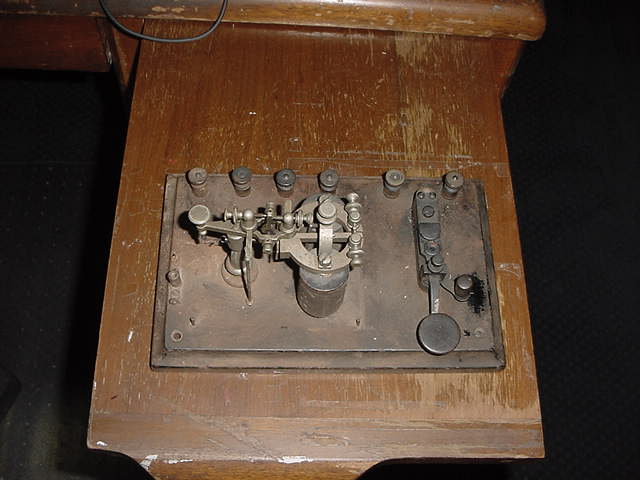
1067a Another perspective view of the
instrument in as-found condition:(38KB)
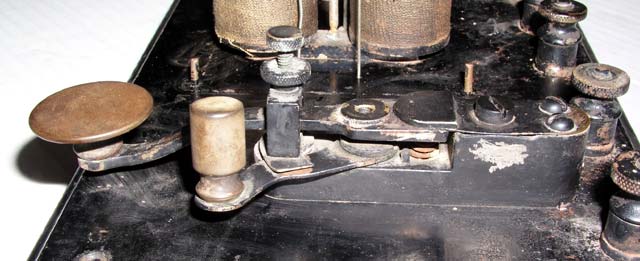
1067i A closer view of the unique Steiner
Key:(36KB)
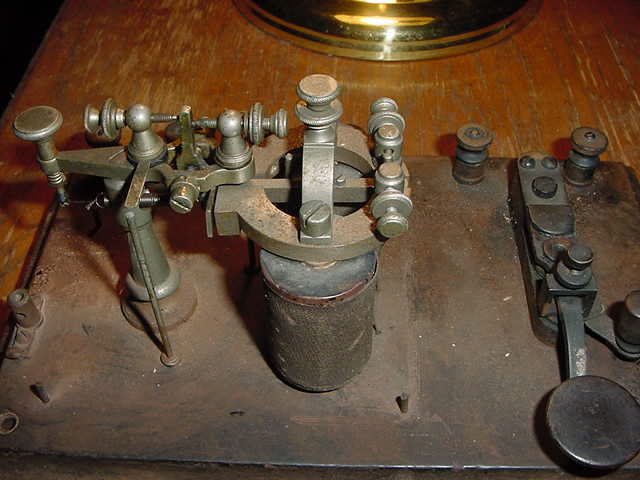
1067b A closer view of the mechanism showing the contacts
that are activated when BOTH of the coils are energized:(37KB)
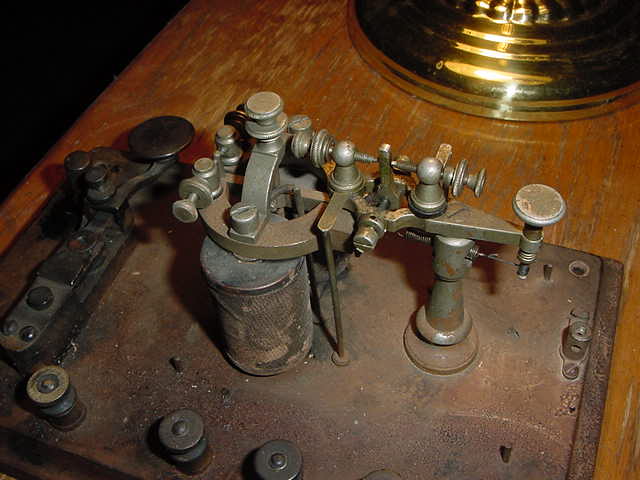
1067c Another close view of the mechanism showing the
contacts that are acrivated when BOTH coils are energized:(37KB)
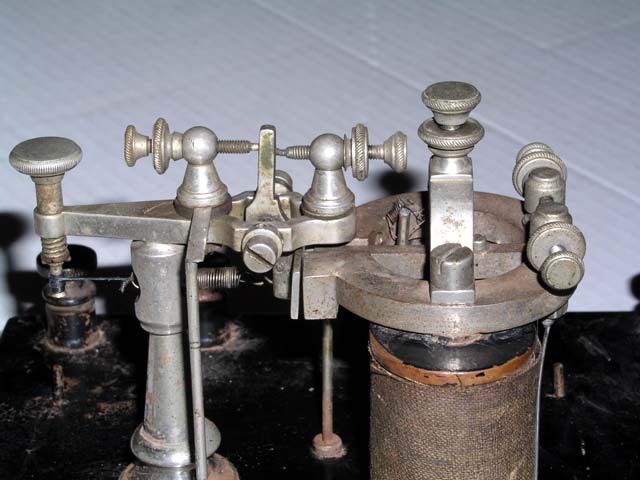
1067j A Close View of the contacts that activate when
BOTH coils are energized:(43KB)
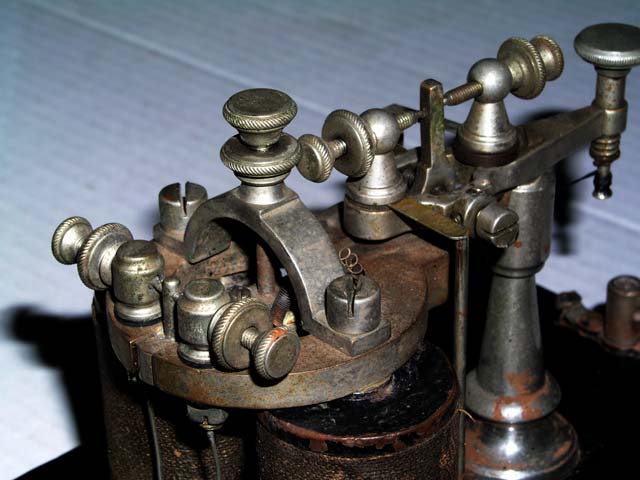
1067k A Close View of the contacts of the Polar Relay that
are activated when One OR the Other coil is energized:(43KB)
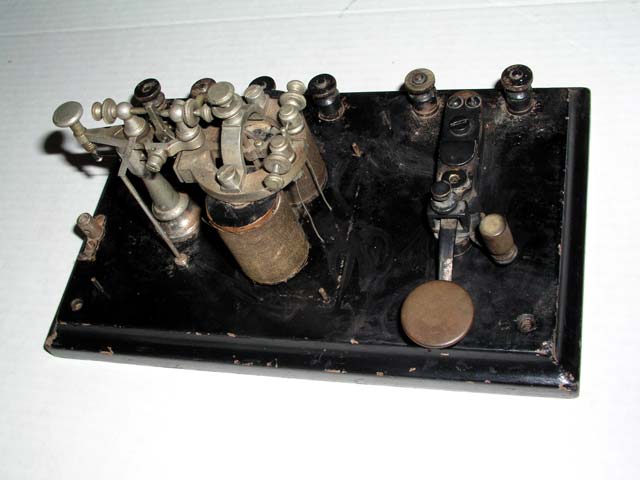
1067g A Right Side View of the KOB after cleaning
the base:(406KB)
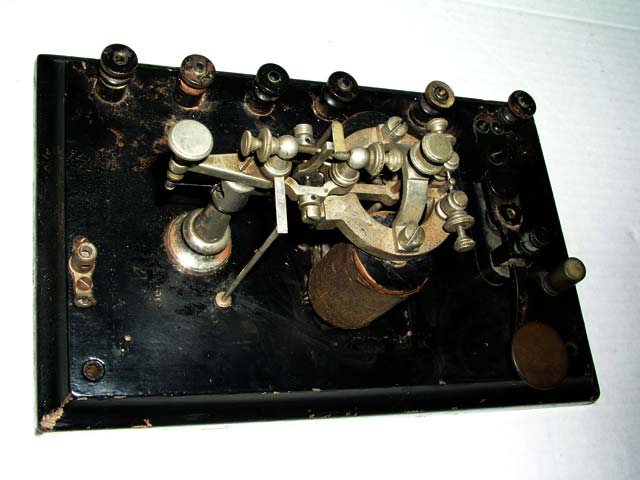
1067h A Left Side View of the KOB after
cleaning:(36KB)
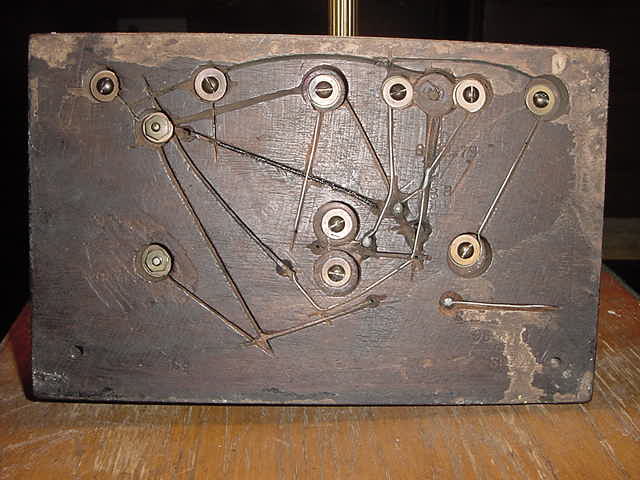
1067d The wiring under the base:(38KB)
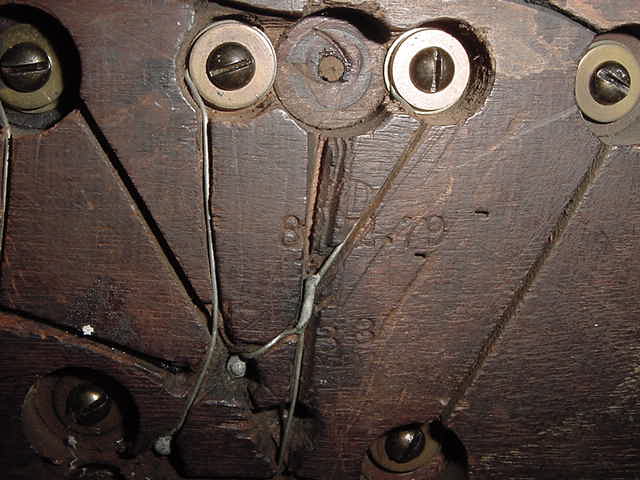
1067e Details of the wiring & markings under the
base:(38KB)

1067f Details of the markings under the
base:(38KB)
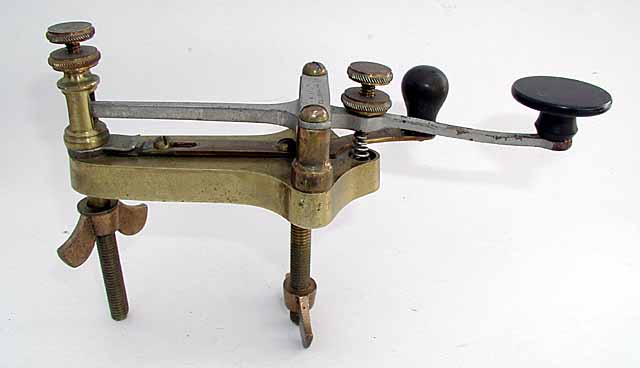
1070 * VERY UNUSUAL LEFLEY LEG KEY:(20KB)
This is a very hard to find key with an unusual shorting lever
which moves forward-and-back rather than side-to-side. Traded to K5VT.
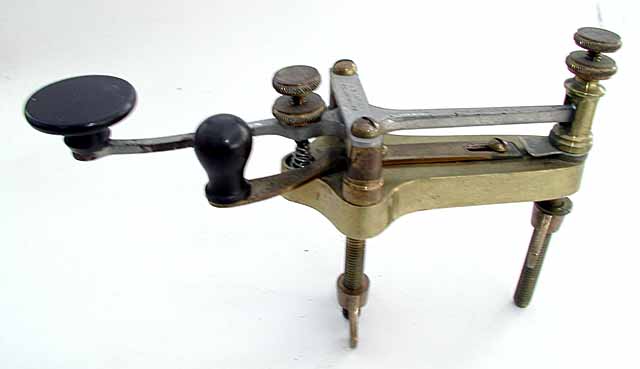
1070a * Another view of the Lefley Key:(18KB)

1070b * Another view of the Lefley Key:(21KB)
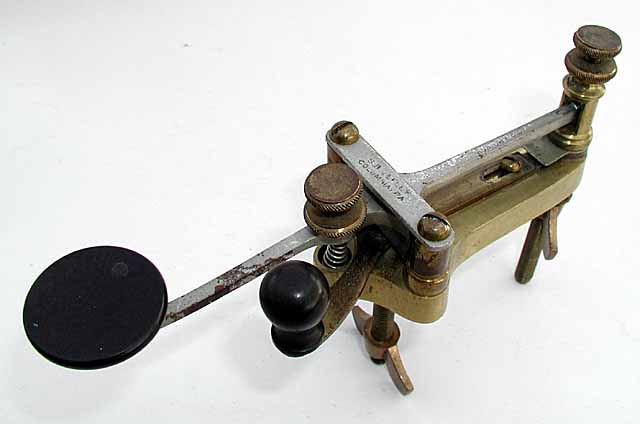
1070c * Another view of the Lefley Key:(22KB)
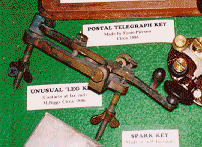
1075 VERY UNUSUAL "M. BIGGS" LEG KEY: (23KB)
Very unusual early all brass design with normally-open contacts out at
far end of key armiture. Brass armiture engraved M. BIGGS. Pat Oct 20,
'86. Standard Electric Co. Louisville, KY. Brass shorting lever and
all brass legs with wing nuts.
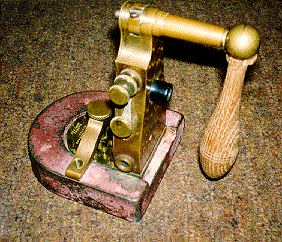
1080 PUMP HANDLE KEY (The "Twentieth
Century Key"):(48KB)
Serial #386. All brass key with hanging wooden lever shaped like
a pump handle, mounted on very heavy cast iron base. Wooden lever is
pushed left to make contact. This key was designed to help overcome
"Telegrapher's Paralysis" which we now call "Carpal Tunnel Syndrome".
A small knob on the front of the key acts as the shorting switch.
Key stamped "Made by Foote Pierson & Co. New York. Pat Applied For."
1082 PUMP HANDLE KEY:1082 ("The Twentieth Century Key").As above.Serial #1067.
(Traded to K5VT).

1125 * MODERN SWEDISH ERICSSON-STYLE KEY:(21KB)
A modern version of the lovely Ericsson keys shown below. (This key
is the same as number 5050.)

1200 LARGE EARLY SWEDISH ERICSSON-STYLE KEY:(15KB)
This is the classic early Swedish land-line key made from the 1870s well
into the 20th Century. The key has a very long lever and a crisp 'feel'.
Operators were trained to sit in front of the operating table with their
upper arm straight down and their lower arm pointing straight ahead. Their
seat height was adjusted so their arms made a right angle with each other.
Their lower arm was thus parallel with the operating table. They were
taught to grasp the key knob firmly with thumb and forefingers and to
use ONLY up and down whole-arm movements to operate the key. You can see
the cuts in the wooden base which were used to allow the wires to come
up to the key connectors from the operating table. This is my
all-time favorite key to own and to operate on the air.
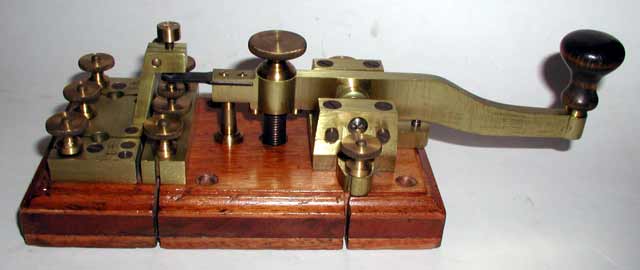
1200a Another View of the Swedish Key:(16KB)
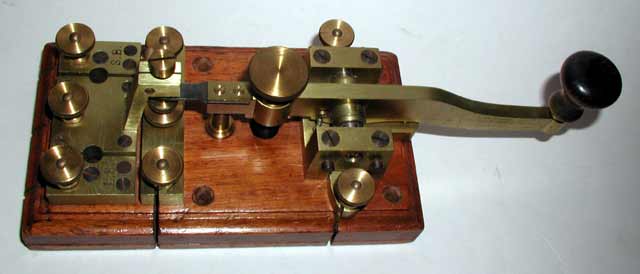
1200b Another View of the Swedish Key:(17KB)

1215 SWEDISH ERICSSON-STYLE KEY: (49KB)
Very large old all-brass key on a wooden base with very long lever and
beautiful brass hardware and switch block. Made in 1880's by ERICSSON
or KUNGLIGA TELEGRAFUERKET (The Royal Telegraph Administration) at
their NYNASHAMN factory S. of Stockholm.
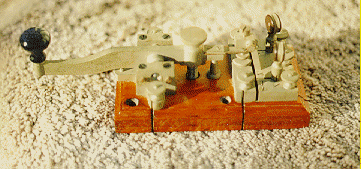
1217 SWEDISH ERICSSON-STYLE KEY: (49KB)
Same as above but plated brass.

1219 SWEDISH ERICSSON KEY: (45KB)
Like 1215 but smaller and perhaps older.
1221 * SWEDISH ERICSSON KEY: More modern version of above. Circa 1960s.
1222 * SWEDISH/NATO ERICSSON-STYLE KEY: Long 7" lever on
brown base. Circa 1960s.
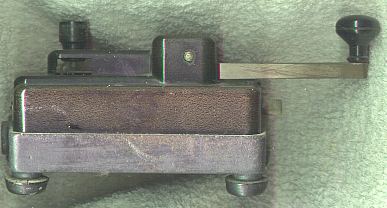
{1222} 5060 * {Duplicated from Wireless Keys section.}
EARLY DANISH - GREAT NORTHERN TELEGRAPH WORKS KEY:
This Danish key carries a label that reads: Great Northern Telegraph Works,
Copenhagen, Denmark. No. 77773. It is not likely that 77773 of these keys
were made since they do not show up very often. I think it is more likely
that the manufacturer started with a high serial number. The picture was sent
to me by another collector.
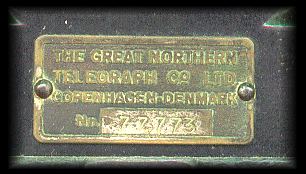
5060a * The Label on the
Early Danish key:
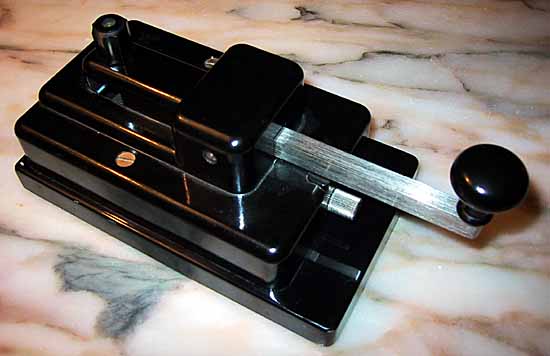
{1223} 5070 * {Duplicated from Wireless Keys section.}
LATER DANISH - GREAT NORTHERN TELEGRAPH WORKS KEY:
This appears to be a later version of the Danish key above. This Danish key
carries a label that reads: Great Northern Telegraph Works, Copenhagen,
Denmark. No. 13779. Since it is not likely that 13779 of these keys were made
it is more likely that the manufacturer started with a high serial number.
Circa 1960s. The picture was sent to me by another collector.
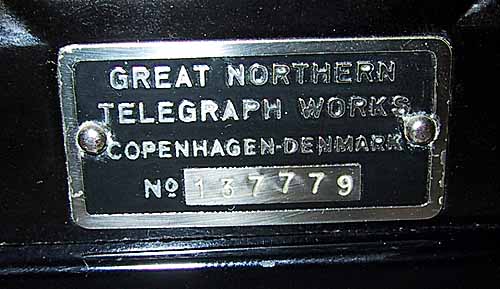
5070a * The Label on the Danish key:
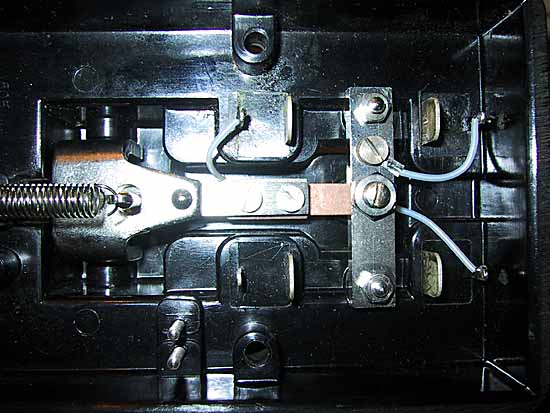
5070b * The Underside of the Danish key:
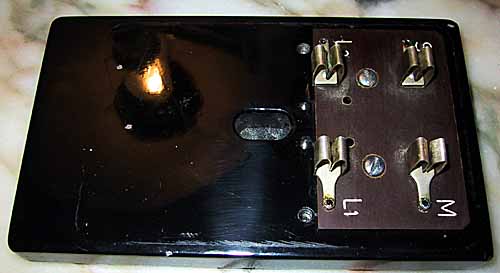
5070c * The Removable Base of the Danish key showing the
modular connectors:
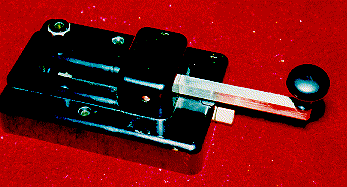
1224 * DANISH ERICSSON-STYLE KEY:(16KB)
Long 7" lever on black plastic base. Circa 1960s.
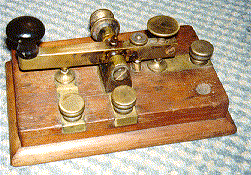
1225 FRENCH PTT KEY:(28KB)
Used in France by the Poste and Telegraph Offices. Massive all-brass
key w/straight lever mounted on well worn wooden base.

1226 FRENCH PTT KEY:(14KB)
Used in France by the Poste and Telegraph Offices. Massive all-brass
key w/straight lever mounted on wooden base.
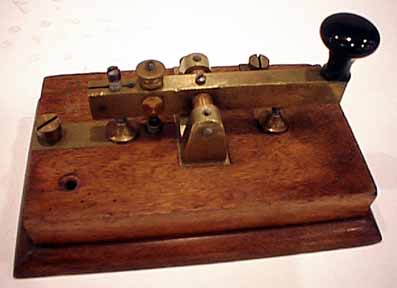
1226a Another view of the FRENCH PTT KEY:(14KB)
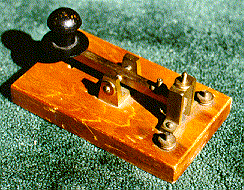
1228 * LARGE WELLS FARGO KEY:(32KB)
Large 5" rectangular brass lever with round, skirted knob mounted
on a 2x5" wooden base. Underside stamped: NATIONAL STATE CAPITAL
BANK, Wells Fargo Agents.
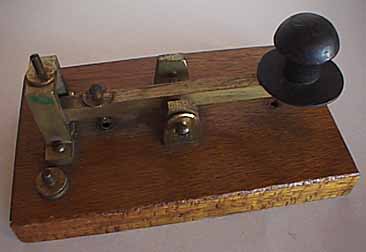
1228a Another view of the WELLS FARGO Key:(12KB)
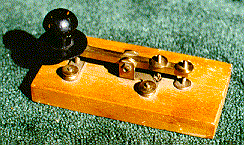
1229 * SMALL WELLS FARGO KEY:(23KB)
As above with 4" lever on 2x4" wooden base.

1235 * EARLY BRITISH TELEGRAPH KEY:(34KB)
Very large all brass key on large wooden base with brass
"SEND - RECEIVE" switch.>>W2PM
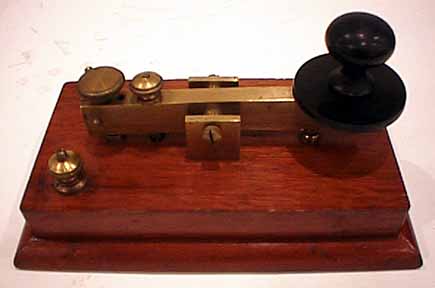
1237 EARLY BRITISH TELEGRAPH KEY:(13KB)
Classic straight lever brass British land-line telegraph key
on wooden base.
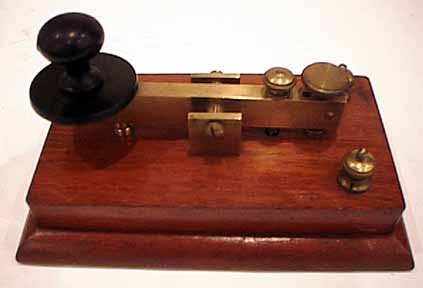
1237a Another view of the British key:(13KB)
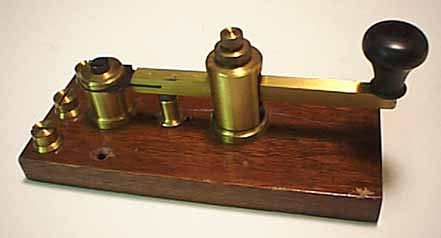
1240 EARLY BRITISH "WALTERS" LAND-LINE KEY:(13KB)
The unique and unusual design of this key includes a flat spring
steel strip (Similar to that on a Steiner Key) instead of a
trunnion shaft. The contacts are enclosed in the round brass
cylinder at the middle of the key.
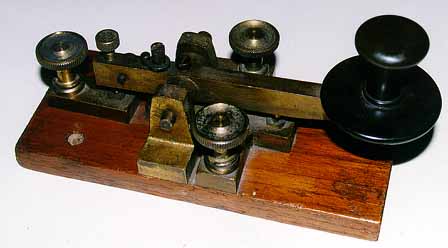
1242 EARLY BRITISH GPO LAND-LINE KEY:(19KB)
This lovely early key is marked PATT 1056A.
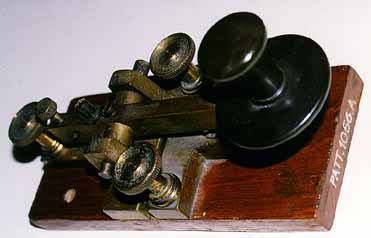
1242a Another view of the BRITISH LAND-LINE
KEY:(16KB)
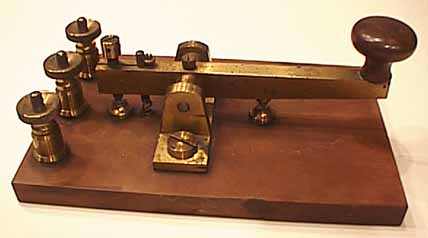
1245 ** EARLY BRITISH LAND-LINE KEY MADE BY ELLIOTT
BROTHERS:(15KB)
This lovely early brass land-line key is owned by
collector Peter Malvasi - W2PM.
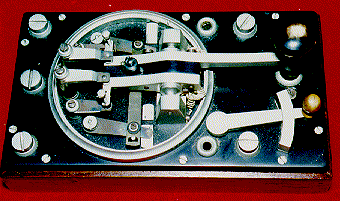
1250 BRITISH DOUBLE CURRENT KEY:(28KB)
Elaborate key with complex mechanism enclosed within a circle.
Sent out a weak negative signal between dots and dashes to
depolarize very long telegraph lines & counteract the capacitance.
I have seen some examples of these keys with the 'Siemens Brothers,
London' label. This one has no label.

1251 BRITISH DOUBLE CURRENT KEY:(38KB)
This is another example of the above key. I have taken pictures
of the complex mechanism to try to clarify its design.
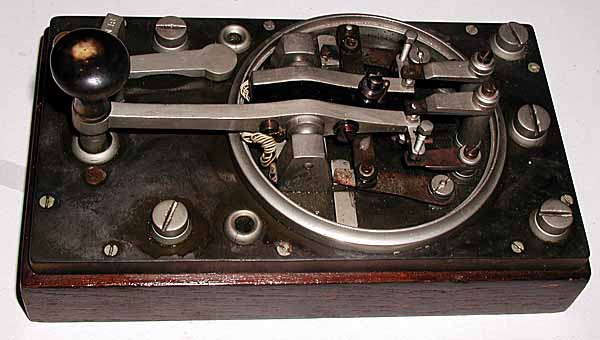
1251a Right-Side top view of the key:(36KB)
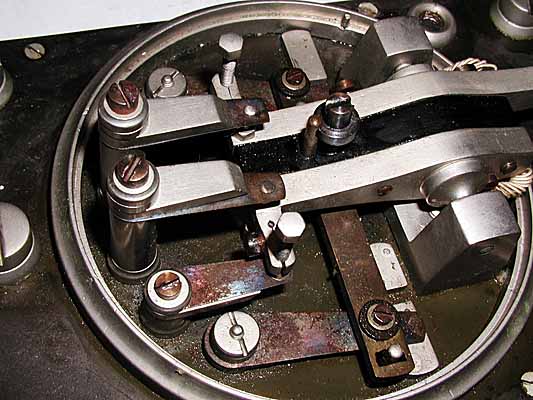
1251b Closer view of the top of the key:(50KB)
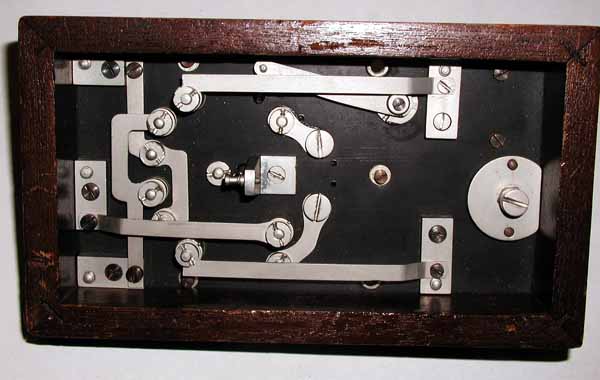
1251c A view of the bottom of the key:(33KB)
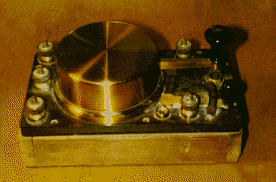
1252 * BRITISH DOUBLE CURRENT KEY: (28KB)
Similar to 1250 but all brass with brass cover over contacts.
Engraved: TYLER & CO., Ltd. 1923 III 1915
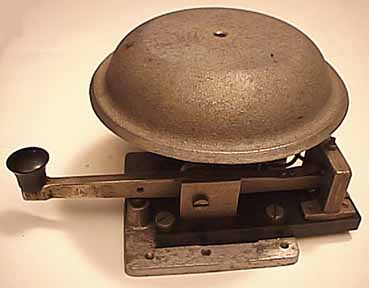
1255 * SPECIAL BRITISH RAILROAD TELEGRAPH KEY: (16KB)
This unusual key is built on the same metal base as a solenoid-operated
bell. It was used on the British Railroads as the bottom element of an LNWR
(London & North Western Railway) block instrument that was made ca. 1890-1925.
A few remain in use to this day.

1255a Closer view of the British Railroad
key/bell: (14KB)
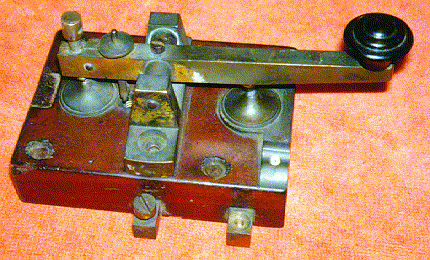
1260 EARLY AUSTRALIAN LAND-LINE KEY:(58KB)
This is the earliest Australian land-line key. Many of the early
features of this key were carried on into later Australian key designs
such as number 1262 and finally into the modern Clipsal keys.
(number 9190).

1262 LATER AUSTRALIAN LAND-LINE KEY:(59KB)
This key shows the design influences from the early Australian key
(number 1260) and led the way to the more modern:

9190 Australian Clipsal key (number 9190):(54KB)
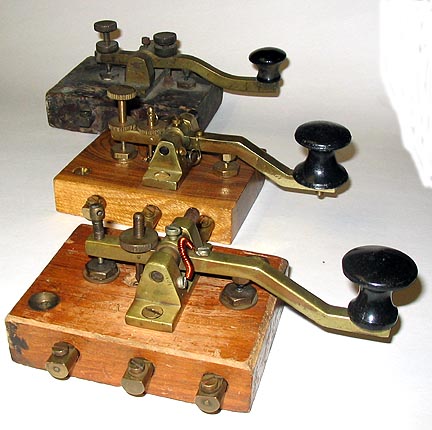
1270 ** INDIAN LAND LINE TELEGRAPH KEYS:
These three keys were purchased in India by collector Jack Klobuchar - W1TEC.
They include one very early and two more recent keys. The oldest key
was made by the India Electric Works Ltd. of Calcutta, India. Keys like these
are still being used on the Indian Railroads. The design appears to have been
patterned after early British keys.
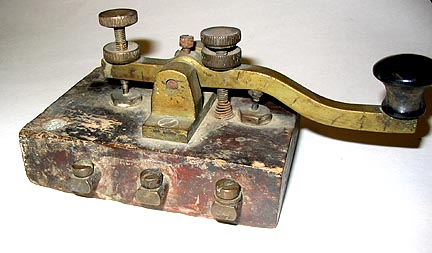
1270a ** A closer view of the oldest Indian Key:
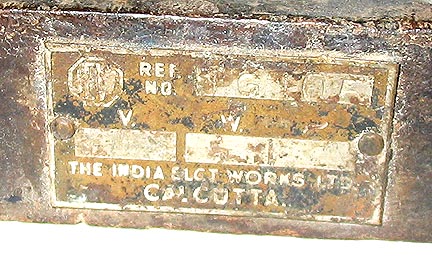
1270b ** A closer view of the label on the
oldest Indian Key:
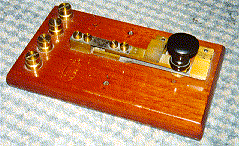
1275 * EARLY FRENCH BRASS STRAP KEY:(22KB)
Unusual old multiple part all brass design marked: SOC DES TELEGRAPHES.
ATELIER C.AL. (Atelier means builder.)
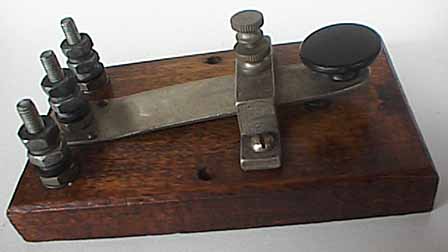
1280 * EARLY BRASS STRAP KEY: (14KB)
This very small early strap key is simply a springy brass
strap with contacts and binding posts mounted on an old
wooden base.

1282 * VERY EARLY HEAVY BRASS STRAP KEY:(28KB)
This medium sized key consists of a heavy springy brass strap with
interesting upper and lower contacts and binding posts mounted on
a heavy black marble-like base.
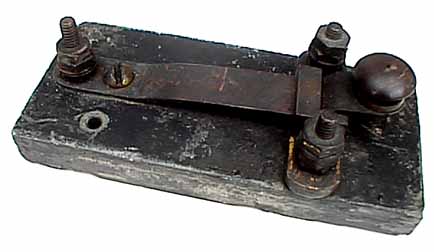
1282a Another closer view of the strap key:(17KB)
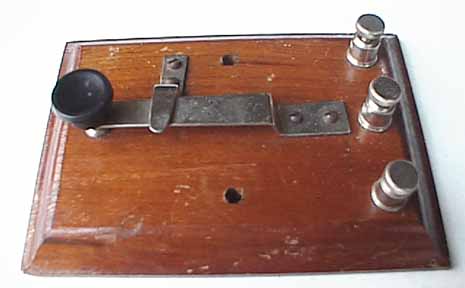
1283 * SMALL STRAP KEY:(15KB)
This small key consists of a springy metal strap with
a set of lower contacts and binding posts mounted on
a wooden board.
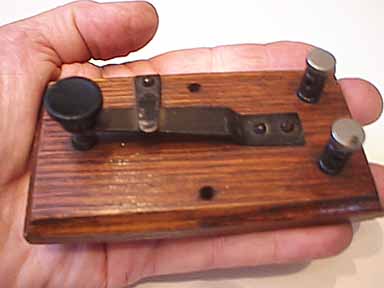
1284 * SMALL STRAP KEY:(14KB)
This small key is similar to number 1283. It
consists of a springy metal strap with
a set of lower contacts and binding posts mounted on
a wooden board.

1290 EARLY SWISS / ITALIAN LAND LINE KEY:(31KB)
Heavy brass key with 1/2 X 5/16 X 4-1/2" straight lever. Adjustable
pull-down spring beyond pivot. Doorknob shaped knob. Make & Break
contacts. Huge adjusting screws. All parts and screw heads are
numbered "12". 5-7/8 X 2-13/16" wooden base with recessed wiring.
Greg Ulsamer, DL1BFE, reports that this kind of key was first made
in the 1850's by a Mechanicus by the name of Kaufman in the town of
Solothurn and later by the 'Eidgenoessische Telegraphenwerkstaette' which
was the workshop of the (governmental) Swiss Telegraph Administration.
Since many of these keys are found in Italy, it has previously
been assumed that they were Italian.

1290a Another view of the Swiss/Italian key:(29KB)

1294 EARLY STYLE SWISS / ITALIAN LAND LINE KEY:(17KB)
This medium sized brass key is typical of the early
straight-lever Swiss/Italian land line keys (See above for an explanation of
the confusion about the key's origin).
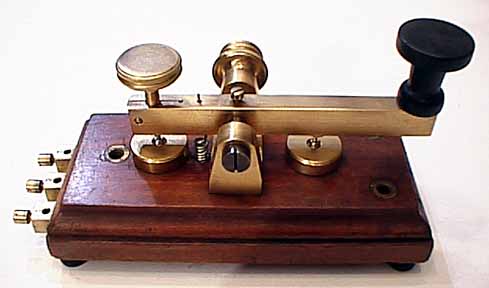
1294a A different view of the Swiss/Italian key:(18KB)
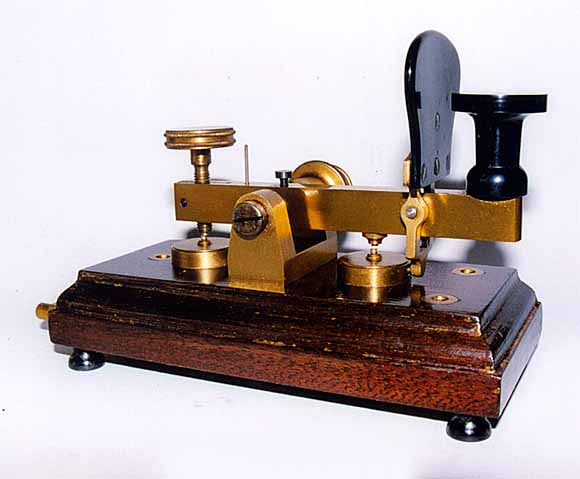
1295 * EARLY STYLE SWISS / ITALIAN LAND LINE KEY:(25KB)
This medium sized brass key has the unique automatic shorting contacts
that are typical of the early Swiss/Italian land line keys. Placing
fingers on the knob pushes a plastic plate forward and unshorts
the key readying it for transmission. Releasing the lever
automatically places it in the receive mode. Greg Ulsamer reports that
this key is called the ''Forchieri-key'' which is a family name from
the Italian portion of Switzerland.
It was first made by the workshops of the Swiss Telegraph
Administration in the 1890s and used on the American type of Closed
Circuit lines in Switzerland.
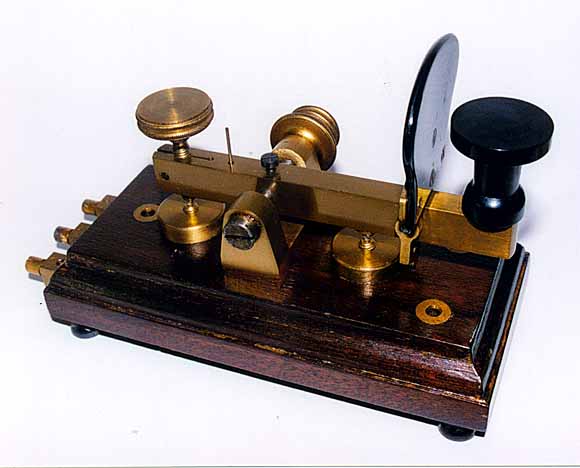
1295a Another view of the Swiss/Italian key:(30KB)
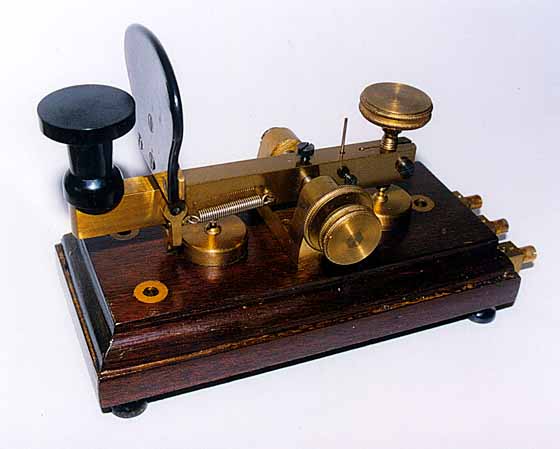
1295b Another view of the Swiss/Italian key:(30KB)
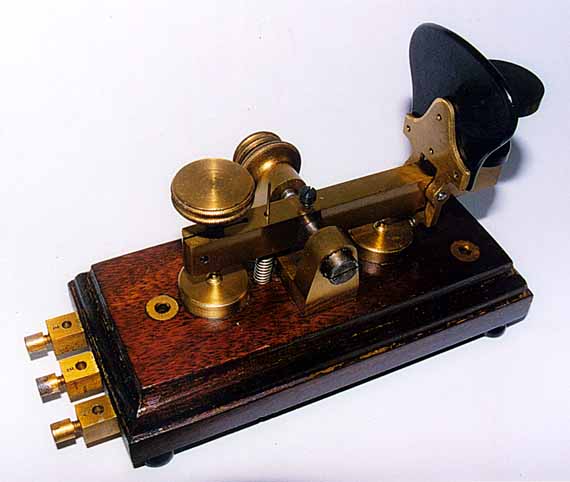
1295c Another view of the Swiss/Italian key:(30KB)
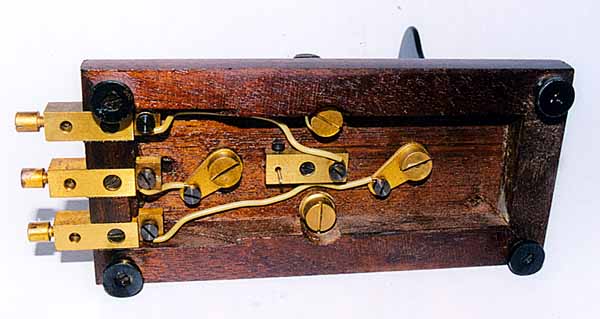
1295d A view of the underside of the base of the
Swiss/Italian key:(30KB)
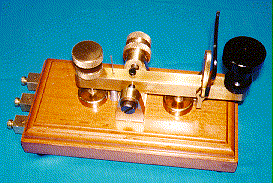
1295r * REPRODUCTION OF THE
EARLY STYLE SWISS / ITALIAN LAND LINE KEY:(25KB)
This key is a recent reproduction made in Italy in the 1990's.
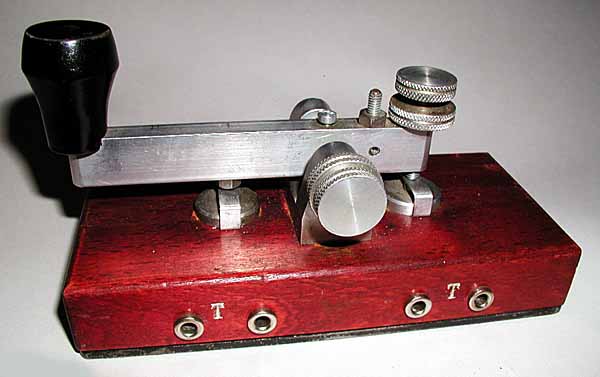
1296 RECENT SWISS PRACTICE LAND LINE KEY:(28KB)
This interesting key has its contacts supported on strips of thin spring
metal. I am told that it was used by the Swiss military for practice...
but the reason for placing the contacts on springs is unclear. The most
likely explanation is that it reduces the noise of the contacts and it is
less likely to annoy or confuse nearby student operators. The maker's
name and location, E. Bischhausen, Bern is stamped on the frame under
the lever.
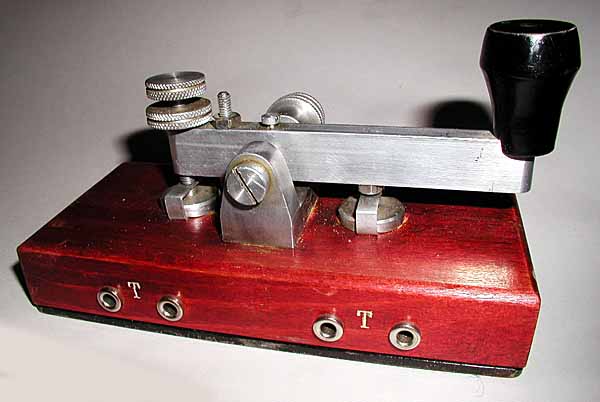
1296a A left side view of the Swiss
Key:(30KB)
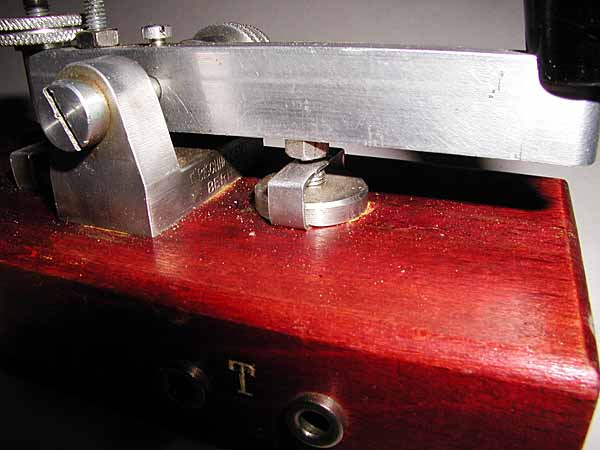
1296b A close-up view of the spring supported contacts
also showing the maker's name and location:(34KB)
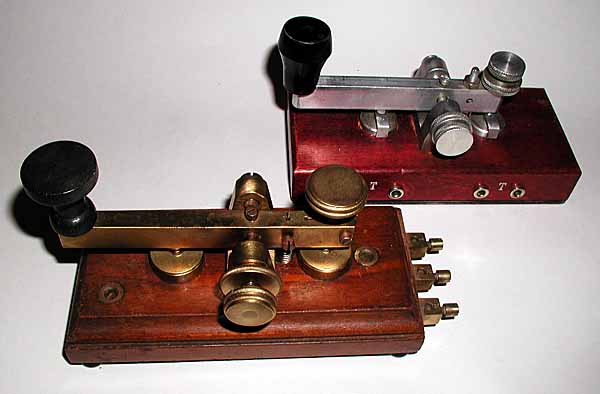
1296c A side-by-side comparison between the Swiss/Italian
key (1294 above) and this Swiss key:(27KB)

1298 * EARLY STYLE GERMAN LAND LINE KEY:(13KB)
This key has the classic straight lever and spring-mounted
normally-open and normally-closed lower contacts that
are uniquely found on virtually all of the early
post-camelback era German keys.
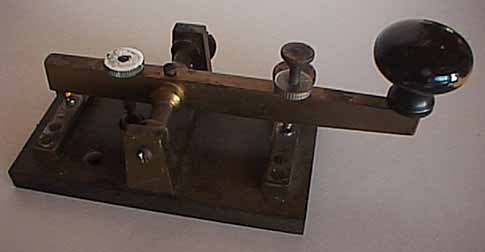
1298a Another view of the German key:(11KB)
1305 LEG KEY, land line, brass with steel lever and brass shorting
switch. Base engraved W.U.Tel.Co. JHBunnell & Co, New York USA. Very
unusual bearings with adjusting screws COUNTERSUNK into cast brass
uprights. Brass wing nuts and washers.

1307 * WESTERN ELECTRIC LEG KEY:(16KB)
Unusual brass key with plated lever consisting of parallel circular
rods. Trunnion reads Pat App'd For. Shorting switch. Quite early.
Circa late 1870s to early 1880s.
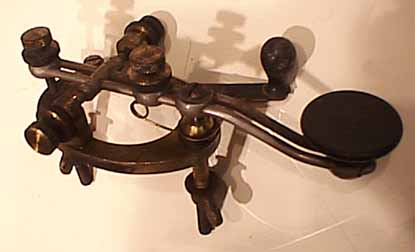
1307a Another view of the Western Electric Leg Key:
(14KB)
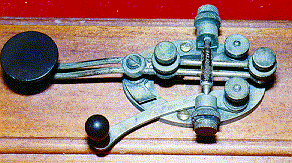
1308 LEGLESS WESTERN ELECTRIC KEY:(29KB)
Parallel rods lever like 1307 above but a legless design
mounted on a wooden base.
1310 MINIATURE BRASS LEG KEY: Unusual small brass key with steel
trunnion press fit into brass lever and normally-closed contacts at far
end of key.
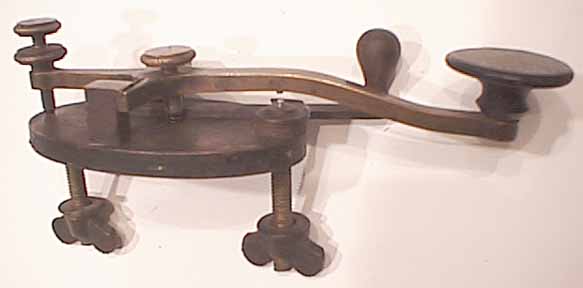
1320 * VICTOR PATENT LEG KEY:(13KB)
Early all brass Victor leg key characterized by knife-edge bearings on
both sides of brass lever which is stamped: Pat Dec 26th,1882.
E.S.Greeley & Co., Successors to L.G.Tillotson & Co. New York.

1320a Another closer view of the knife-edge
bearings:(14KB)

1325 VICTOR LEG KEY:(31KB)
This early all-brass Victor leg key is characterized by the unique
Victor patent knife-edge bearings on both sides of the brass lever
which is stamped: Pat Dec 26th,1882.
E.S.Greeley & Co., Successors to L.G.Tillotson & Co. New York.
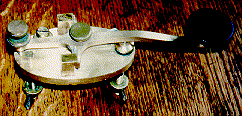
1325.gif Another view of the VICTOR LEG KEY:(18KB)
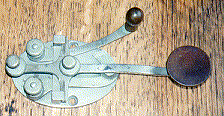
1327 VICTOR LEGLESS KEY:(18KB)
All Nickel plated as above. Stamped: Western Electric.
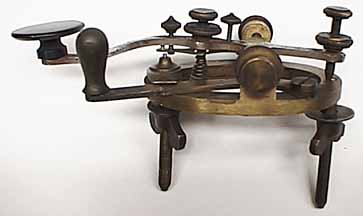
1335 VERY UNUSUAL WESTERN UNION/BUNNELL LEG KEY:(13KB)
This key stamped "W.U.TEL.CO. and Bunnell has an unique additional
spring plate between the contacts that is adjusted by Phelps style
screws.
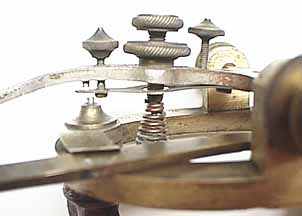
1335a CLOSE-UP VIEW OF SPECIAL SPRING ON ABOVE
KEY:(13KB)
1340 MESCO LEG KEY, land line, brass with steel lever. Thick brass base
engraved "M E S C O" (Manhattan Electric Supply Co.)
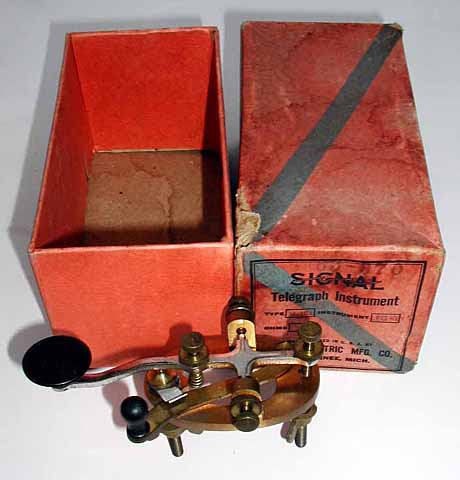
1345 SIGNAL ELECTRIC CO. LEG KEY IN ORIGINAL
BOX:(28KB) This is a new Signal Electric Co. Leg Key with the original
box. The markings on the box include a place to list the 'ohms' suggesting
that the same box was used for their sounders and relays.

1345a A closer view of the label on the
box:(43KB)

1350 BUNNELL LEG KEYS:(24KB)
Land line, brass with steel lever stamped "Patented Feb 15,1881".
Brass shorting switch. Base stamped JHBunnell & Co,New York
USA. Brass wing nuts.
1351 * LEG KEY, Like 1350 but lever stamped BUNNELL inside rectangular box.
1352, * & 1253 LEG KEY, Same as 1350 but lever not stamped.
1355 * LEG KEY, Same as 1350 but missing one wing nut and the insulated leg.
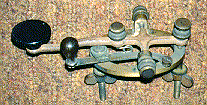
1361 LEG KEY:(17KB)
Land line, brass with unusual thick steel lever with all edges
beveled. Brass base stamped Nat Elec Mfg Co.
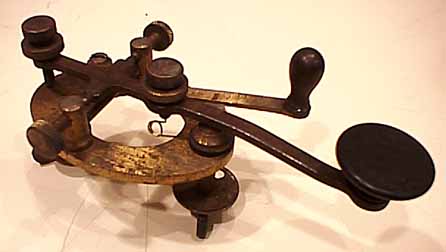
1370 * UNUSUAL LEG KEY:(16KB)
This is a brass land line key with an unusual heavy brass base
and with an unususal brass rod running from left to right
under the trunnion.
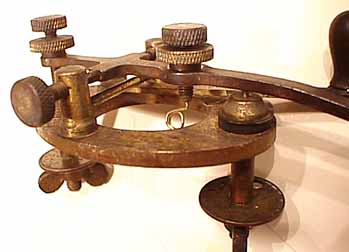
1370a Another view of the unusual leg key:(16KB)
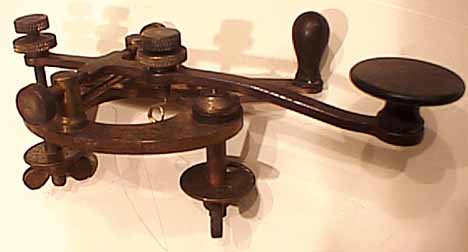
1370b Another view of the unusual leg key:(15KB)
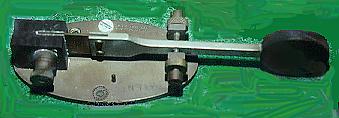
1440 UNUSUAL BUNNELL SIDESWIPER MODEL 'G':(11KB)
Unique early Bunnell design in which the upright support is made of
insulating material. It looks very much like the standard Bunnell model "W"
so-called "double speed key" but has a very different design. Historian John
Casale-W2NI believes that it was named after Geohegan who worked for Bunnell
and probably invented it. Base engraved PATENTED JHBunnell & Co, New York
USA.

1441 BUNNELL "SIDESWIPER":(12KB)
This is the early Bunnell model "W" so-called "double speed key" supposedly
patented in 1888 and designed to overcome "telegrapher's paralysis" (Now known
as Carpal Tunnel Syndrome). Has the old style black insulators and a shorting
switch. Base engraved PATENTED JHBunnell & Co, New York USA. Historian John
Casale-W2NI has presented convincing evidence that this key was actually
patented after 1900.

1442 * BUNNELL SIDESWIPER:(10KB)
Similar to above.
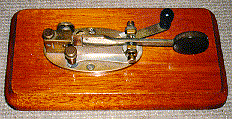
1443 * BUNNELL SIDESWIPER:(17KB)
Similar to above.
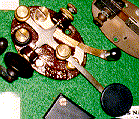
1450 * FOOTE PIERSON LEGLESS LAND LINE KEY:(13KB)
Steel armiture, Brass hardware and reddish painted cast iron base
with raised, cast-in lettering: "Postal Telegraph Company" Brass shorting
bar is engraved "Made By Foote-Pierson & Co. New York."
1451 FOOTE-PIERSON LEGLESS KEY: This looks like the Bunnell Triumph key
but shorting lever stamped FOOTE-PIERSON. Base stamped LEGLESS KEY,2-A,
W.U.TEL. CO.

1452 * LEGLESS TELEPLEX LAND LINE KEY:(6KB)
Cast iron base. No shorting switch. Mounted on bakelite base with
stick-on emblem "Manufactured by TELEPLEX, NewYork,N.Y.
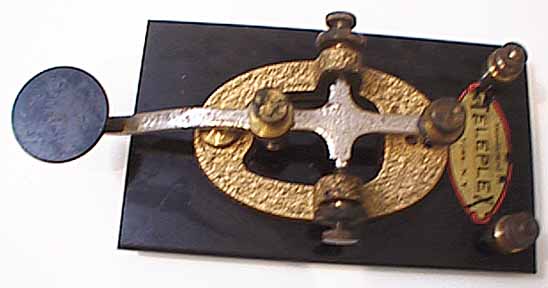
1453 * LEGLESS TELEPLEX LAND LINE KEY:(21KB)
Similar to # 1452.

1454 * LEGLESS LAND LINE KEY:(9KB)
Cast Iron base and no shorting lever mounted on a wooden base. Unique
lever is made of two pieces of brass stock which have been riveted
together at the center where they cross.
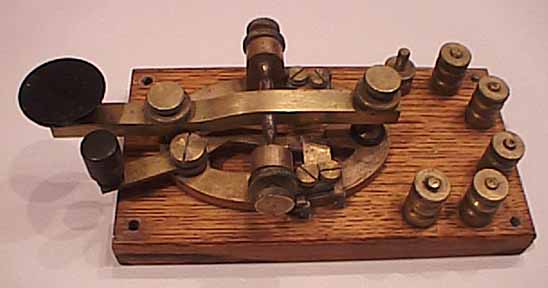
1455 VERY UNUSUAL MULTIPLE CONTACT LEGLESS
LAND LINE KEY:(19KB)
This strange key has normally open and normally closed contacts
as well as multiple contacts which can be closed or opened by
moving the sorting switch lever left or right. I am looking for
more information on this key.
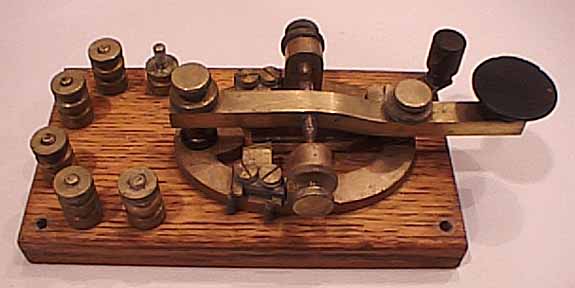
1455a Another view of the multiple contact
key:(21KB)
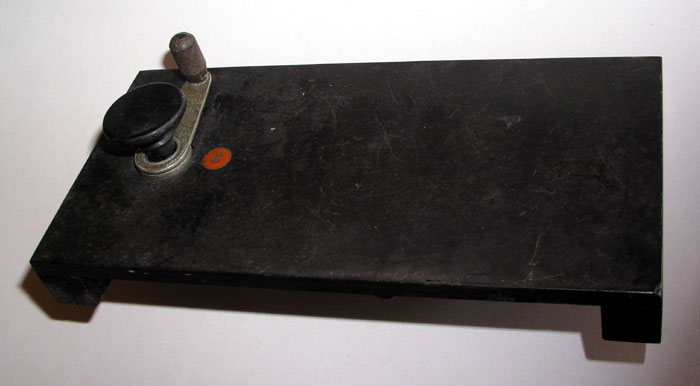
1456 WESTERN UNION 4B PANEL MOUNT TELEGRAPH KEY:
This key mounted on a panel. The shorting switch lever also extends through
the panel.
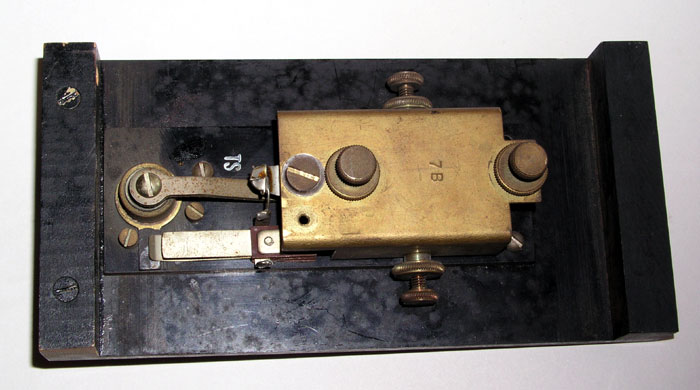
1456a Back view of the Panel Mount Key.
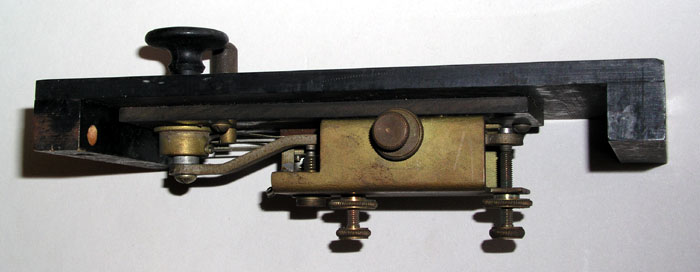
1456b Right side view of the Panel Mount Key.
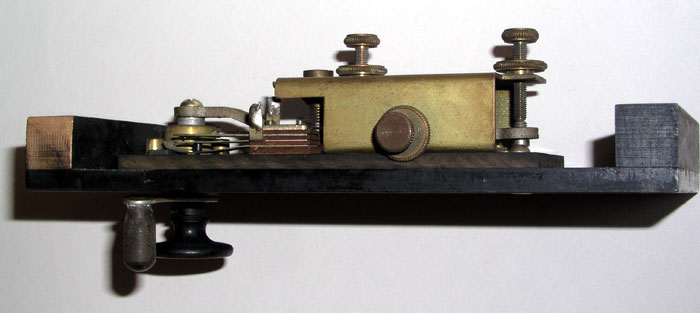
1456c Left side view of the Panel Mount Key.
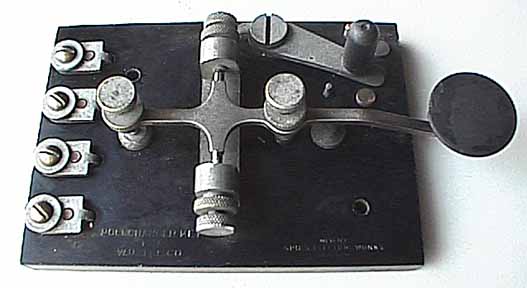
1457 LEGLESS LAND LINE "POLECHANGER" KEY:(22KB)
With black bakelite base engraved "1-B W.U. Tel. Co. Mfg by Speis
Electric Works, Chicago". Plated brass construction mounted on heavy
black with plated three-pole changer switch.

1458 UNPLATED BRASS POLECHANGER KEY:(20KB)
Same as 1457 but unplated brass.
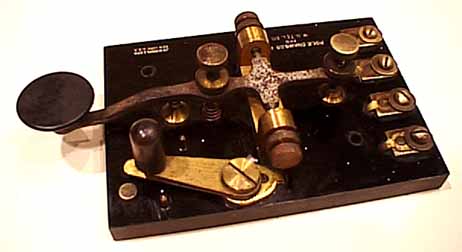
1458a Another View of the unplated polechanger
key:(18KB)

1459 * POLECHANGER KEY WITH OVAL BRASS BASE:(15KB)
Similar to 1458 but key has oval brass base.
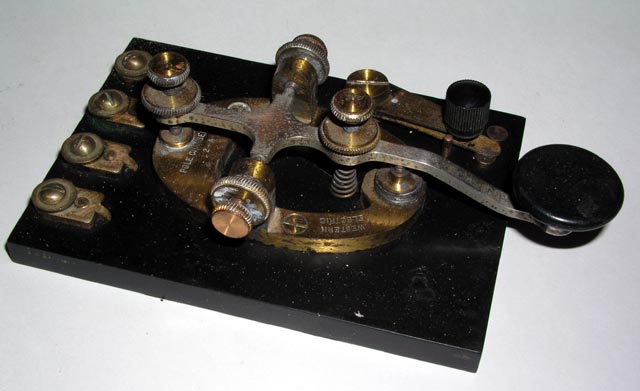
1459a * Another view of the Polechanger Key:
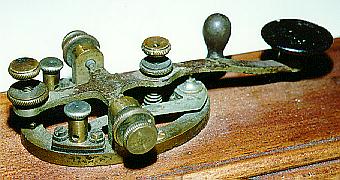
1460 BUNNELL LEGLESS LAND LINE KEY:(24KB)
Brass base engraved: "Mfg by JHBunnell, New York USA." Very early all
brass key with shorting switch and steel lever. The electrical terminals
are unusually well machined and are screwed to the brass base with fine
brass screws. Mounted on a wooden base.
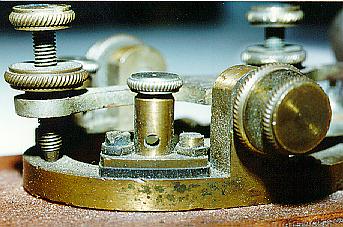
1460 A close-up view of the terminals:(28KB)
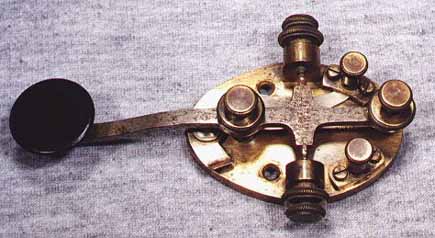
1460b ** HARD-TO-FIND EARLY BUNNELL
LEGLESS TRIUMPH KEY WITH SOLID BASE:(24KB)
This key is similar to number 1460 and has the very early
elevated terminals but it also has a solid brass base.
(In the John Casale - W2NI Collection.)
1461 LEGLESS land line key: Brass base engraved:"Mfg by
JHBunnell,NewYork USA." Also, barely visible under the "hot" terminal is
engraved: "POSTAL TEL CO. This is the very early "Triumph" key design
all brass key with shorting switch, steel lever, and early style
cylindrical electrical terminals.
1462 LEGLESS land line key: Brass base engraved:"Mfg by JHBunnell,
NewYork USA." The early "Triumph" key design all brass key with shorting
switch and cylindrical electrical terminals. The steel lever is
engraved "BUNNELL S".
1463 WESTERN ELECTRIC "LEGLESS" key: This all-brass key with steel
lever looks like a Bunnell "Triumph" key made for Western Electric.
Stamped"TELEGRAPH KEY 1A, AT&T CO." on the brass base & "WESTERN
ELECTRIC" on shorting bar.

1464 WESTERN UNION "LEGLESS" KEY:(8KB)
This all-brass key with steel lever looks like a Bunnell "Triumph" key
made for Western Union. Stamped "LEGLESS KEY,W.U.Co."
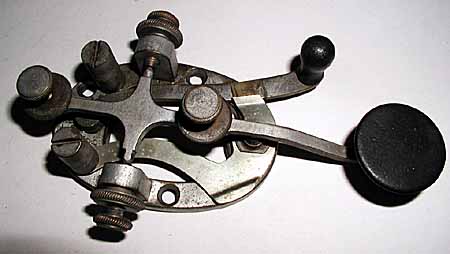
1465 CHAS CORY & SON - WESTERN UNION "LEGLESS"
KEY:(20KB)This is the classic Western Union Telegraph key.
The far end is stamped: Legless Key 2A Western Union. The shorting
lever carries the stamp: CHAS CORY & SON, NY which suggests that the
key was used by the Cory Company.

1465a Closeup of the CHAS CORY stamp:(25KB)

1466 * EARLY BUNNELL LEGLESS KEY:(9KB)
This key has black cast oval iron base with brass hardware and a steel
lever engraved "BUNNELL". It is mounted on an old wood base with screw
contacts stamped J.H.Bunnell Co.,NewYork U.S.A.
1468 LEGLESS LAND LINE KEY: Mfg by JHBunnell but labeled Western Electric
on the shorting lever and "A T & T Telegraph Key" on the all brass
base. This is the early "Triumph" key design all brass key with a steel
lever.

1469 LEGLESSS LAND LINE KEY:(7KB)
Same as above on wooden base.
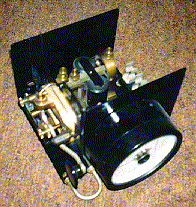
1470 * LEGLESS LAND LINE KEY,
SOUNDER, & TEST SET:(26KB)
Triumph Key as above mounted on a black metal bracket with Western
Electric zero center 10-0-10 milliammeter on front of bracket and brass
Western Electric sounder & other components inside bracket. (Traded to
John Casale - W2NI.)
1473 * LEGLESS land line key Mfg by JHBunnell but labeled Western Electric
on the shorting lever and "(H) A T & T Telegraph Key" on the brass
base. This is the early "Triumph" key design brass key with steel lever,
On a white marble base.

1474 * Same as above:(7KB)
Mounted on black bakelite base.
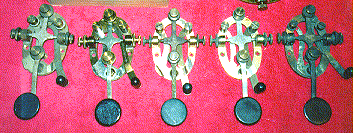
1475 * Same as above:(32KB)
Engraved"(N)AT&T Telegraph Key" on the brass base.Unmounted.
1476 * LEGLESS land line key Mfg by JHBunnell, New York, USA. The early
"Triumph" key design all brass key with cylindrical electrical
terminals.No shorting switch, and no identification on brass base.
Mounted on marble base.
1477 * LEGLESS land line key probably Mfg by JHBunnell, New York, USA. but
marked Manhattan Supply Co., New York on the brass base. This is the
early "Triumph" key design all brass key with tapered electrical
terminals, no shorting switch, and steel lever. This key was probably
manufactured for Manhattan Supply Co by Bunnell before they changed
their name to Manhattan Electric Supply Co.
1479 * LEGLESS land line key with shorting lever which is stamped
"Standard Electric Mfg. Co., Menominee, Mich". This key has a brass
base, shorting lever, and hardware with steel lever and shorting strap.
It is mounted on a marble base.
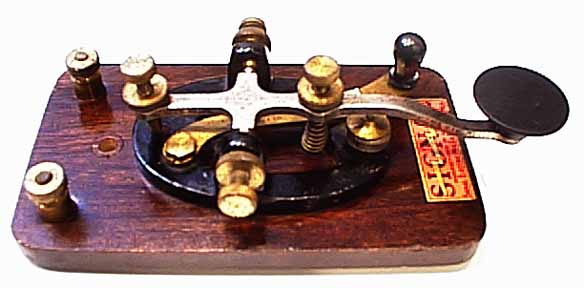
1480 * LEGLESS SIGNAL ELECTRIC COMPANY LAND LINE
KEY:(25KB)This is a typical steel-lever oval-based land line
key. It is mounted on a wooden base which displays the
Signal Electric Company Decal. Many of these keys were used
for training purposes.
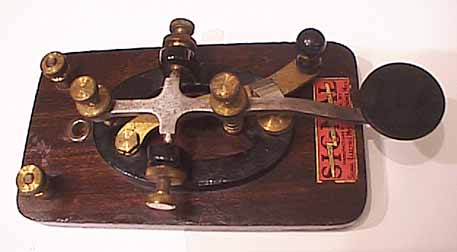
1480a Another view of the key:(16KB)
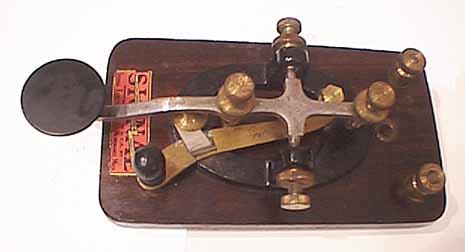
1480b A right side view of the key:(15KB)
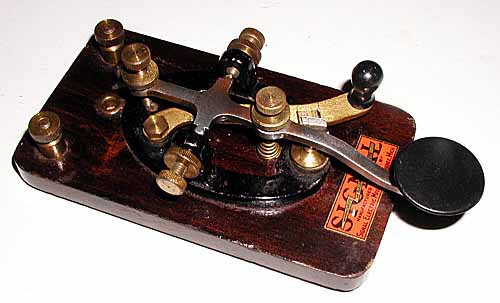
1480c Another similar Signal Electric Key:(27KB)
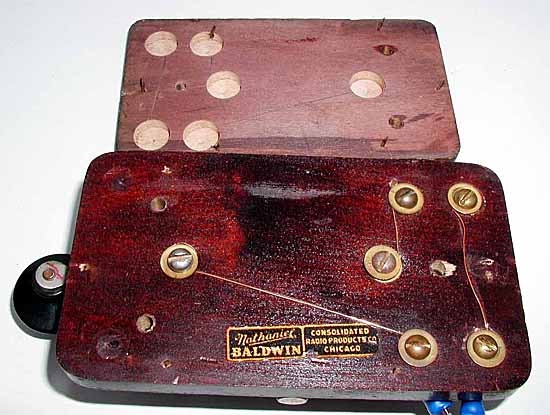
1480e A Signal Electric Key sold by NATHANIEL
BALDWIN:(47KB) This is a very unusual key. It is a typical Signal
Electric Legless Key but it carries the Nathaniel Baldwin-Consolidated Radio
Products Co. Chicago... label under its base and has a special second wooden
base which has been drilled out to make room for the contact screws and then
nailed to the underside of the key. The bindiing posts have been drilled out
to accept the pin jacks of a pair of headphones (presumably the Baldwin
Headphones.) The top of the key also carries the WW-2 US Army Signal Corps
insignia in red.
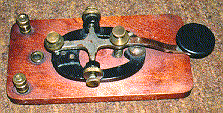
1481 * EARLY BUNNELL STRAIGHT KEY:(20KB)
Cast iron based key mounted on newer oak base.
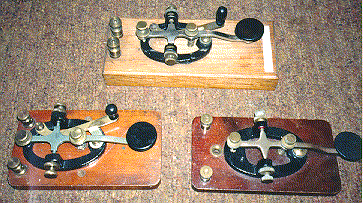
1482 * BRASS "MESCO" KEY:(51KB)
(Manhattan Electric Supply Company.)
1483 Same as above but steel lever stamped with military type number.

1484 * J.H.BUNNELL "TRIUMPH" KEY:8KB)
Brass key with steel lever stamped BUNNELL.
1485 * STRAIGHT KEY: Black cast base with cylindrical Bunnell style
terminals and "Triumph" style steel strap to 1/8" hot contacts. No
shorting lever or ID.
1486 * UNUSUAL LEGLESS KEY: This key has a black cast iron base with
chrome plated hardware and a steel lever. The bearings are screwed into
the bearing supports and locked in place with hex nuts. They have
slotted ends to accept a screwdriver.
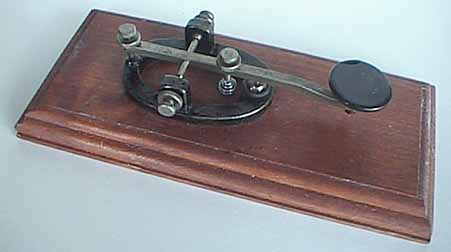
1487 * UNUSUAL LEGLESS KEY:(14KB)
This key has a black cast iron base and chromed hardware. The
armiture is an almost straight 3/16" square steel bar with round
steel trunions press-fit through it like the early camelbacks.
The spring rests directly on the wooden base.

1488 * UNUSUAL LEGLESS KEY:(6KB)
This key has a black cast iron base and chromed hardware. The armiture
is an almost straight 1/4" square steel bar with round steel trunions
press-fit through it like the early camelbacks. The spring rests on a
round nubbin cast into the base.
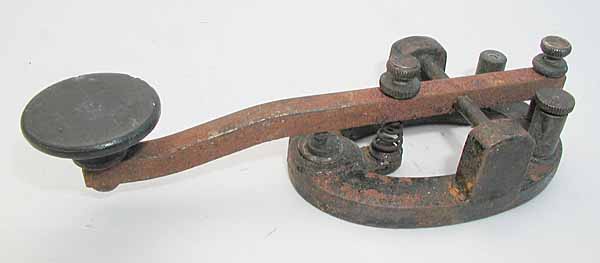
1489 UNUSUAL LEGLESS KEY:(15KB)
This key has a black cast iron base and chromed hardware. The
unusual aspect of the key is that the trunnion supports have no
adjusting screws and the trunnion is simply inserted into each side.
This key is in quite rusty condition and its unusual design
suggests that few were made.
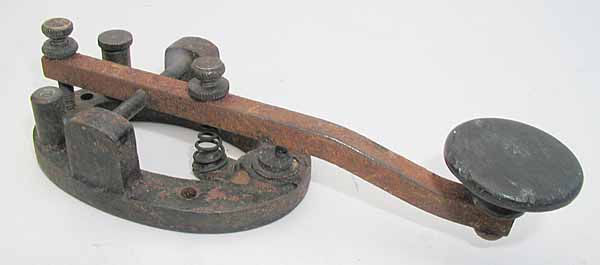
1489a Another view of the UNUSUAL LEGLESS
KEY:(15KB)
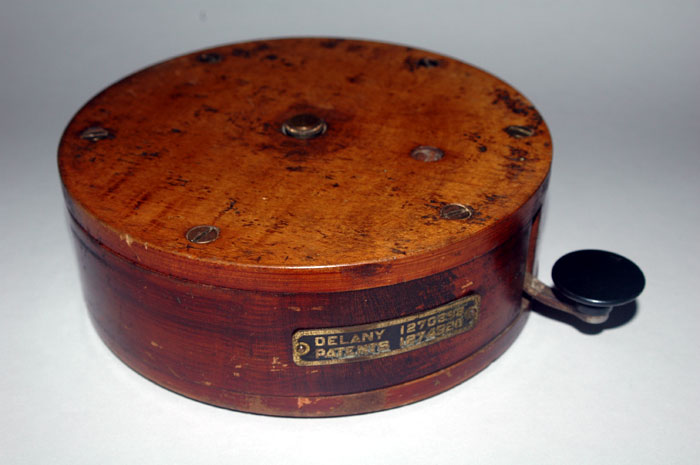
1490 VERY UNUSUAL DELANEY PATENT KEY IN ROUND BOX
USED FOR CONVEYING MORSE CODE OVER THE TELEPHONE:(51KB)
This device consists of a J.H.BUNNELL "Triumph" key mounted inside an
extremely well made 6" diam. circular wooden box. The metal label on
the outside reads "DELANY PATENTS 1270398 1274520". There are absolutely NO
electrical connections to the key which is entirely enclosed inside the
box with the exception of the end of the lever and knob which extend out of
the side of the box. The original 1917 patent sent to me by the well-known
telegraph historian and key collector Roger Reinke shows that this key was
placed underneath a candlestick telephone and that pressing the lever made a
mechanical clicking sound against the base of the telephone which could be
heard and read as morse code by the person on the other end of the telephone
line. This seems very funny since there was already voice communication with
the person on the other end of the line. Could it have been an early attempt
at providing secure communications that could not have been listened in upon
unless the eavesdropper knew the morse code? - But then, almost everyone knew
the morse code in those days. ??
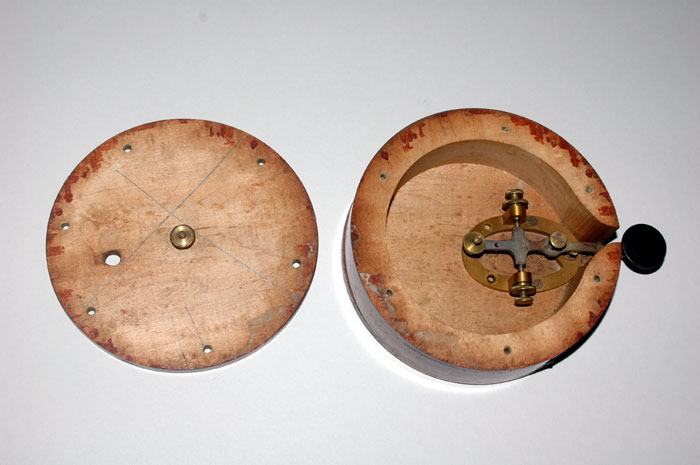
1490a The Telegraph-by-Telephone Key in its box:
(49KB)
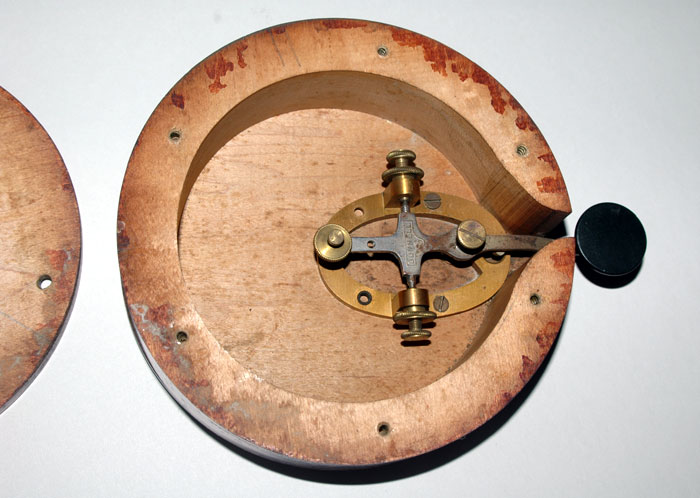
1490b A Closer View of The Telegraph-by-Telephone Key
in its box:(72KB)
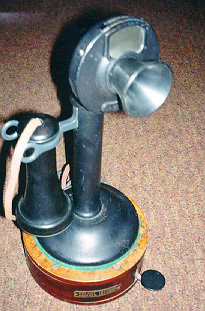
1490c The Telegraph-by-Telephone Key and a
candlestick telephone in operating position:(85KB)

1490d The Original Patent for the Telegraph-by-Telephone
Key:(183KB)
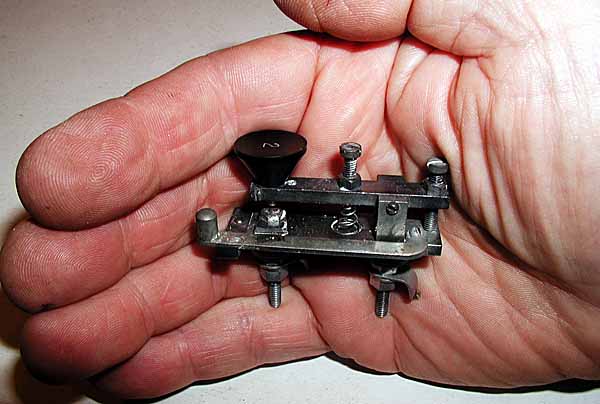
1495 TINY WESTERN ELECTRIC TELEGRAPH KEY:(35KB)
These tiny keys have a nice action and are often used by telegraph
operators who need an extremely small key. The keys have metal shorting
levers and knobs numbered from 1 to 4. Originally, they all came from a
Western Electric Telegraph Line Test Set. (See 1495b below). These
test sets are of no practical use these days and most have
been discarded after the keys were removed.

1495a Closeup of Western Electric Mini-Key:(35KB)
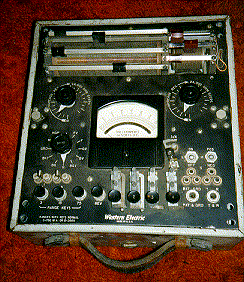
1495b * WESTERN ELECTRIC TEST SET &
TINY KEYS:(40KB)
PLEASE SEE PART II FOR CONTINUATION:
CONTACT INFORMATION
Please Note: IF YOU DO NOT RECEIVE AN ANSWER TO YOUR EMAIL
IT MEANS THAT I CAN NO LONGER RESPOND.
Please use internet search engines to find other information if you do not receive a reply.
Professor Tom Perera
Ph. D. - W1TP
Professor Emeritus:
Montclair State University
Go to Tom Perera's Professional Neuropsychology Home Page.
- Email Address:
(To help me avoid automated 'junk mail' programs,
I ask you to type my email address as
follows with no spaces between words:)
- PLEASE TYPE: keys
- THEN TYPE THE @ SYMBOL
- THEN TYPE: w1tp.com
- Please NOTE: { it is w1tp - W then the NUMERAL "1" (one) then tp }...
(It is NOT wLtp or wItp).
- Please NOTE: IF YOU DO NOT RECEIVE AN ANSWER TO YOUR EMAIL IT MEANS THAT I CAN NO LONGER RESPOND.
Please use internet search engines to find other information if you do not receive a reply.
- Please NOTE: You MUST include the word
KEYS in the Email Subject Line.
- Please Sign your email.
IF you do not receive a reply my spam cleaner might have intercepted your
email.
Pease try again with a different Subject and Text.
- ( Please Enquire Before Sending Attachments Larger Than 1MB - Thank
you.)
Internet On-Line Telegraph & Scientific Instrument Museums:
http://w1tp.com
Internet ENIGMA Museum:
https://EnigmaMuseum.com
COPYRIGHT NOTICE: (Copyright (c) 2023: Prof. Tom Perera Ph. D.)
Although all the pictures and text are copyrighted, you may use any of them
for your own personal applications including public lectures and
demonstrations, publications and websites as long as you mention the
w1tp.com Museum. If you plan to offer them for sale to the public
in any form, please email me for permission which I will generally grant as
long as you mention my museum: http://w1tp.com or https://EnigmaMuseum.com My email address is
given at the bottom of this page. Some of the material may require contacting
other copyright owners for commercial use and I will inform you by email.
Please also see the Disclaimer of Warranty.















































































































































































